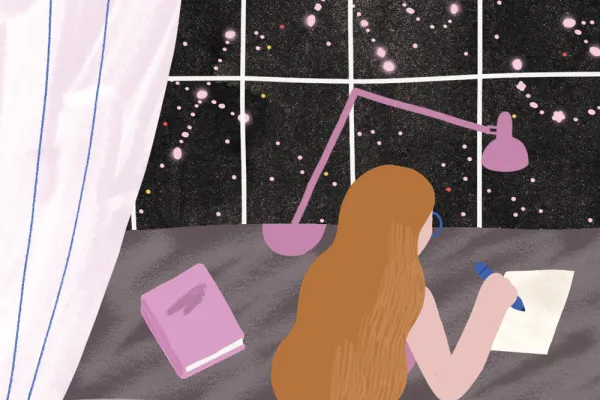Freeing My Inner Mathematician
Alum News

Published September 28, 2020
In high school, I dropped out of calculus with a failing grade. In college in New York’s Hudson Valley, I studied anthropology and film. After college, I took a job that interested me—at least until it felt routine a couple of years later. I pined for a challenge I couldn’t exhaust, which is how I found myself studying math at night in my 20s, while working full time to support myself. Though I longed to become a mathematician, I worried that the door was closed to me.
 By chance, I met Smith math professor James Henle (now Myra M. Sampson Professor Emeritus of Mathematics and Statistics) at a mathematics conference. When Jim learned of my dream, he suggested that I spend a year at Smith taking undergraduate math classes. I explained that I had already graduated from college and had no money for such an undertaking. He then devised a plan— seemingly out of thin air—in which I would enroll in Smith’s M.A.T. (Master of Arts in Teaching) in mathematics program with full funding. He suggested I could prioritize the required undergraduate math classes in the program, which would prepare me for a mathematics doctoral program. Soon after, I quit my job, moved to Northampton and found myself standing at the Grécourt Gates, entertaining my improbable dream.
By chance, I met Smith math professor James Henle (now Myra M. Sampson Professor Emeritus of Mathematics and Statistics) at a mathematics conference. When Jim learned of my dream, he suggested that I spend a year at Smith taking undergraduate math classes. I explained that I had already graduated from college and had no money for such an undertaking. He then devised a plan— seemingly out of thin air—in which I would enroll in Smith’s M.A.T. (Master of Arts in Teaching) in mathematics program with full funding. He suggested I could prioritize the required undergraduate math classes in the program, which would prepare me for a mathematics doctoral program. Soon after, I quit my job, moved to Northampton and found myself standing at the Grécourt Gates, entertaining my improbable dream.
One year is not a lot of time to prepare for the challenges of mathematics graduate school. At Smith, I enrolled in advanced undergraduate math classes, asked questions in professors’ office hours and enjoyed traditions like math tea and colloquium. Mathematics professor Christopher Golé was new to the college that year. On his first day teaching complex analysis, he came across as brilliant and friendly, if a bit nervous. My much younger classmates had far fewer gaps in their math backgrounds; they at least knew that complex analysis was calculus with imaginary numbers. Still, Chris never doubted my ability to become a mathematician—a perspective I soon adopted. Smith had “vaccinated” me against ever thinking I did not belong in this field with an unfortunate history of omitting women.
At the end of my year at Smith, I was admitted to Dartmouth’s mathematics doctoral program. I have great affection for the many supportive people I encountered at Dartmouth. However, I also faced individual and institutional barriers. In my final year, I was pregnant with my first child when my department chair told me point-blank, “Now that you plan to be a mother, I no longer consider you a serious candidate for the degree.” Had I elected to take time off to give birth, I would have lost my graduate fellowship, scholarship and housing—all of which I needed to remain a degree candidate. I returned to the department within days of giving birth, still bleeding and with leaking breasts and a cracked tailbone from childbirth. Though I was required to teach, I was not allowed to place my daughter— Sophia, named after Sophia Smith—in faculty child care. I arranged a patchwork of babysitters for when I taught, but otherwise kept her at my side until I graduated. When I defended my dissertation, Jim Henle came up from Smith to serve as the outside faculty member on my committee. It was great to see him there.
I thought of Smith often as I wrote my new book, How to Free Your Inner Mathematician: Notes on Mathematics and Life. Smith is not only where I began to free my inner mathematician, but it is where many women who possess significant mathematics potential do the same. Apparently I was the test case for Smith’s Center for Women in Mathematics postbaccalaureate program that was founded in 2007, not long after my departure. Thank you, Smith College, for understanding that women mathematicians count.
Susan D’Agostino, M.A.T. ’98, is a writer and mathematician in Stratham, New Hampshire, and is working toward a master’s in science writing at Johns Hopkins University. Her book, How to Free Your Inner Mathematician: Notes on Mathematics and Life, was published in May by Oxford University Press.
This story appears in the Fall 2020 issue of the Smith Alumnae Quarterly.
SMITH IN MY LIFE
Have a story about how Smith has influenced your life? Send your 600-word essay to saq@smith.edu for consideration.
Illustration by Louise Reimer